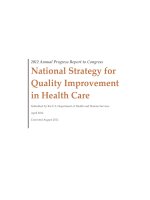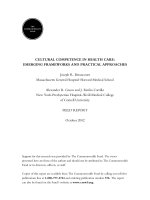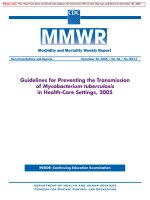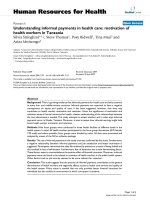Irrationality in health care what behavioral economics reveals about what we do and why
Bạn đang xem bản rút gọn của tài liệu. Xem và tải ngay bản đầy đủ của tài liệu tại đây (11.05 MB, 312 trang )
Irrationality in Health Care
Irrationality
in Health Care
What Behavioral Economics Reveals
About What We Do and Why
Douglas E. Hough
Stanford Economics and Finance
An Imprint of Stanford University Press
Stanford, California
Stanford University Press
Stanford, California
Song lyrics at the beginning of Chapter 8:
The Song That Goes Like
From MONTY PYTHON’S SPAMALOT
Lyrics by Eric Idle
Music by John Du Prez and Eric Idle
Copyright © 2005 Rutsongs Music and Ocean Music
All Rights Reserved Used by Permission
Reprinted by Permission of Hal Leonard Corporation
©2013 by the Board of Trustees of the Leland Stanford Junior University.
All rights reserved.
No part of this book may be reproduced or transmitted in any form or by any
means, electronic or mechanical, including photocopying and recording, or in
any information storage or retrieval system without the prior written permission
of Stanford University Press.
Special discounts for bulk quantities of Stanford Economics and Finance are
available to corporations, professional associations, and other organizations.
For details and discount information, contact the special sales department of
Stanford University Press. Tel: (650) 736-1782, Fax: (650) 736-1784
Printed in the United States of America on acid-free, archival-quality paper
Library of Congress Cataloging-in-Publication Data
Hough, Douglas E., author.
Irrationality in health care : what behavioral economics reveals about what we
do and why / Douglas E. Hough.
pages cm
Includes bibliographical references and index.
ISBN 978-0-8047-7797-1 (cloth : alk. paper)
1. Medical economics—United States. 2. Medical care—United States.
3. Health behavior—United States. 4. Economics—Psychological aspects.
I. Title.
RA410.53.H669 2013
338.4'73621—dc23
2012039953
Typeset by Thompson Type in 10/15 Sabon
DEDICATION
To Edie with gratitude,
and to Katerina and Kai,
who I hope will have a better health system when they need it
CONTENTS
List of Anomalies
Preface and Acknowledgments
ix
xiii
1 What Is Behavioral Economics—
and Why Should We Care?1
2 Keeping What We Have, Even If We Don’t Like It25
3 Managing Expectations and Behavior69
4 Understanding the Stubbornly Inconsistent Patient100
5 Understanding the Stubbornly Inconsistent
Consumer136
6 Understanding the Medical Decision-Making
Process, or Why a Physician Can Make the Same
Mistakes as a Patient173
7 Explaining the Cumulative Impact of Physicians’
Decisions201
viii
Con t en ts
8 Can We Use the Concepts of Behavioral Economics
to Transform Health Care?229
References249
Index279
A nomalies
anomaly 1: Why does the public support the specific
aspects of health care reform but not the bill that was
passed that contained these provisions?
39
anomaly 2: Why did a person in a congressman’s town
hall meeting shout, “Keep your government hands off
my Medicare!”?
44
anomaly 3: Why was there such an uproar in November
2009 when the U.S. Preventive Services Task Force released
its recommendations for screening mammography?
44
anomaly 4: Why do opponents—and proponents—of the
Patient Protection and Affordable Care Act believe that
the law will have a larger impact on the health care sector
than it probably will?
78
anomaly 5: Why would requiring everyone to buy health
insurance make everyone—including those who don’t want
to buy health insurance—better off?
83
anomaly 6: Why would giving consumers lots of choices
in their health plans be a bad idea?
89
x
A nom a lies
anomaly 7: Why do patients insist on getting a prescription,
shot, test . . . when they go to a physician with an ailment?
110
anomaly 8: Why do many patients not adhere to their
diagnostic and treatment regimens?
115
anomaly 9: Why do patients make different treatment
choices when benefits and risks are presented in different
ways?118
anomaly 10: Why are bad habits (such as alcoholism,
smoking, overeating) easy to form and hard to break,
but good habits (such as exercise, eating fresh fruits and
vegetables) hard to form and easy to break?
125
anomaly 11: Why are patients oblivious of the “real”
price of their health care—and why does this lack of
attention promote price inflation?
142
anomaly 12: Why do people buy health insurance that
covers small dollar “losses” (for example, physician office
visits)?147
anomaly 13: Why did health care utilization and spending
jump in the Rand Health Insurance Experiment when price
went to zero—with no improvement in health outcomes?
151
anomaly 14: Why do patients/consumers shun free or
low-priced health care products (for example, generic drugs)
and services (for example, community health) that have
the same efficacy as higher-priced products and services?
Why do they think that more expensive is better?
154
anomaly 15: Why will some people give away a valuable
asset (such as their blood or a kidney) that they would
not sell?
159
anomaly 16: How can a physician diagnose a problem
by spending only a short time with a patient, often
without lab work or images? And why is this so unnerving
to patients?
180
A nom a lies
xi
anomaly 17: Why do many physicians take a long time
to adopt a new procedure, drug regimen, or treatment
protocol that has demonstrated efficacy? In particular,
why don’t physicians wash their hands as frequently as
they should?
185
anomaly 18: Why do physicians’ clinical decisions
depend on how the options are framed?
188
anomaly 19: Why do physicians keep practicing defensive
medicine even in states with malpractice reform?
190
anomaly 20: Why does physician adherence to clinical
guidelines decline when financial incentives are removed?
192
anomaly 21: Why do physicians practice differently in
different communities, even though the communities
may be similar?
202
anomaly 22: Why do tens of thousands of patients die
each year in the United States from central line–associated
bloodstream infections—even though a simple five-step
checklist used by physicians and nurses could reduce that
number by two-thirds?
210
anomaly 23: Why do medical errors—many of which
would seem to be easily avoided—still exist?
217
Pr e fac e a n d Ac k now l e dgm e n ts
The epiphany came slowly. I know that is an oxymoron, but there is no
better way to describe it. I was trained as a mainstream, neoclassical
economist, transfixed by the discipline’s combination of mathematics
and real-world applications. To me, economics provided a superb set of
tools for analyzing and understanding the world—thinking on the margin, opportunity costs, the fundamental theorem of welfare economics.
And in the 1970s, when I was in graduate school, economics was so successful that it was extending its intellectual reach beyond the analysis of
markets to the whole range of human behavior—the family, education,
urban problems (such as crime and urban renewal).
It seemed obvious then that mainstream economics offered the best
way to analyze the myriad of problems that were plaguing the U.S.
health care sector. My colleagues and I at the Center for Health Policy
Research at the American Medical Association devised all sorts of economic theories of physician and hospital behavior—even though none
of us had ever actually seen the management or operations of a physician practice or a hospital. Other health economists, some with more
practical experience than us, were also using neoclassical economics to
explain what was going on in health care. We were following the path
xiv
p r e fac e a n d Ac k now l e d g m e n t s
blazed by the giants in the field: Kenneth Arrow (Arrow 1963), Victor
Fuchs (Fuchs 1975), Mark Pauly (Pauly 1968), and Uwe Reinhardt (Reinhardt 1972).
When I moved into the consulting world, I continued to use these
concepts. They certainly seemed more useful than the other strategy
tools that we had. But I began to get the gnawing suspicion that the assumptions and models of mainstream economics were not all that appropriate for analyzing the financing and delivery of health care in the
United States. Patients certainly did not have the usual characteristics of
a consumer: They were not knowledgeable about the characteristics and
benefits of the services that they were buying; they seemed disconnected
from the purchase decision because their health insurance was paying
for most of their care; and there was not a lot of evidence that the health
care services that they received delivered sufficient value for the rapidly growing expenditure. Likewise, physicians were not acting like the
profit-maximizing businesspeople that we all were hypothesizing: They
were motivated by a much more complex set of goals, and many resisted
viewing themselves as suppliers in a market. Finally, hospitals (at least
the ones I consulted with) certainly did not fit the theory of the firm that
we were taught in school.
But, as Nobel laureate Milton Friedman has argued, scientific theories do not have to be perfect; they just have to be better than the alternatives. And, in the 1970s and 1980s, there were no viable alternatives to
neoclassical economics for analyzing health care. Then in 1986 I stumbled across a curious article in the premier journal in economics, The
American Economic Review, “Fairness as a Constraint on Profit Seeking: Entitlements in the Market,” by Daniel Kahneman, Jack Knetsch,
and Richard Thaler (Kahneman, Knetsch, and Thaler 1986). Fairness
had never been an area that had drawn much attention in mainstream
economics, but the results of the authors’ experiments resonated with the
kinds of behavior I was seeing in health care.
As a consultant, my job was not to read and think deep thoughts
about the issues of the day but to help clients solve problems. So I started
to read the nascent literature in behavioral economics only casually. Then,
I moved to Johns Hopkins University, to run the Business of Medicine
p r e fac e a n d Ac k now l e d g m e n t s
xv
program and teach the medical economics courses. At first, I taught the
standard material, assigning the usual microeconomics textbooks and
journal articles in health economics. The students—all in health care,
many of them faculty in the medical school—dutifully completed their
assignments but increasingly disagreed with the assumptions and models
of neoclassical health economics. As a result, I started to introduce some
of the research on behavioral economics—even though none of it dealt
with health care. The students responded immediately. So, I added more
and more, until I had to offload most of it into a new course on behavioral economics and health care.
My new course has been a real eye-opener for me. The students,
who have extensive clinical or administrative experience in health care,
have been enthusiastic in applying behavioral economics to health care.
Through assignments I gave them, discussions in class, and my own
thinking, I began to assemble a series of what I called “anomalies” in
health care—behavior that neoclassical economics could not explain or
could not explain very well. (I used the term anomalies, in part, as a
tribute to Richard Thaler, who pioneered a section with that title in The
Journal of Economic Perspectives.) I began to realize that behavioral
economics was much more useful in explaining these anomalies.
In addition, I scoured the health economics literature to see the extent to which the field had begun to apply the tenets of behavioral economics. I found only a few examples in the past decade, such as Richard
Frank (Frank 2007), George Loewenstein (Loewenstein 2005), and
Kevin Volpp (Volpp et al. 2008; 2011). Their excellent work has begun
to encourage other health economists to explore the value of this new
discipline.
I wrote this book for four purposes. First, I wanted my colleagues in
health economics to appreciate the power of behavioral economics and
to use it to advance the field. Second, I wanted physicians and leaders
of health care institutions to recognize how their decisions are often affected by a set of biases that can derail their efforts on behalf of patients.
Third, I wanted health policy makers to see how they can apply the
tools of behavioral economics to improve the delivery and financing of
health care. Finally, I wanted to introduce lay readers to the concepts of
xvi
p r e fac e a n d Ac k now l e d g m e n t s
behavioral economics and to help them see how these concepts applied
to the challenges we face in the U.S. health care system.
It would be overconfidence bias on my part to expect that I can accomplish all four goals. In the end I will be satisfied if this book helps
to start a different conversation on how to improve the state of the U.S.
health care system. I welcome your thoughts.
Ack now l edgm e n ts
Every book results from the work of many people, even if only one name
is on the title page. This book is no exception. It is usually good politics
for an author to thank his editor in the acknowledgments. In this case,
my thanks are heartfelt, as well. Margo Beth Fleming was supportive of
this project from the beginning and used an extraordinary combination
of support and cajoling to get a deadline-challenged author to say what
he wanted to say in a way that would appeal to actual readers. I also
want to thank my two peer reviewers, Richard Scheffler and an anonymous referee, who also were both supportive and appropriately critical
of earlier drafts. Ryan Fongemie did an excellent job of designing the
figures from my sometimes sketchy ideas.
I need to thank Dr. Ned Calonge, Dr. Peter Pronovost, and Professor George Loewenstein for their time and valuable insights that illuminated the ways in which behavioral economics can explain what is
going on in health care and health care reform. I also want thank to four
faculty colleagues at Johns Hopkins University: Steve Sisson, for being
an articulate and reflective diagnostician; Ed Bessman, for his insightful and iconoclastic views on medicine and economics; Harold Lehman,
for his expertise in medical decision making; and Todd Dorman, for his
unvarnished comments on my chapters on physician decision making.
I could not have written Chapter 2 had it not been for two people (in
addition to Dr. Calonge): Dean Lucy Marion, PhD, RN, FAAN, for her
insights on the workings of the U.S. Preventive Services Task Force and
the controversy surrounding the 2009 mammography guidelines; and
Dean Janet Allen, PhD, RN, FAAN, for making the introductions to the
USPSTF that I never would have gotten in any other way.
p r e f a c e a n d A c k n o w l e d g m e n t s xvii
Finally, I want to salute each of the students in my behavioral economics course in the fall of 2011: Anna Diller, Vinnie Gopaul, Kristi
Guenther, Jin Won Noh, Olumayowa Osibodu, Kaustubh Radkar, Abhishek Raut, Matt Scally, Sumeet Srivastava, Carrie Stein, Femi Taiwo,
Tiffany Wandy, and Kim Weatherspoon. Their intelligence, intellectual
curiosity, and enthusiasm made me realize that my initial ideas on behavioral economics and health care actually made some sense.
Irrationality in Health Care
1
W h a t I s B e h av ior a l
Economics—a nd W hy
Should W e Ca re?
It is time, therefore, for a fundamental change in our approach.
It is time to take account—and not merely as a residual category—
of the empirical limits of human rationality, of its finiteness in
comparison with the complexities of the world with which it must cope.
—Herbert Simon (1957)
The health care industry in the United States is peculiar. We spend close
to 18 percent of our gross domestic product on health care, yet other
countries seem to get better results—and we really don’t know why.
Most health care products and services are produced by private organizations, yet federal and state governments pay for about half of these
services. More starkly, those who consume health care do not pay for it,
and those who do pay for that care do not consume it. That is, patients
pay less than 15 percent of their care at the point of purchase, the rest
being picked up by their employers, private insurance companies, Medicare, or Medicaid (which have no need for physician visits, medications,
or surgeries themselves). Health care is also peculiar on the supply side.
Unlike in every other industry, the people who fundamentally determine
how resources are allocated—that is, the physicians—rarely have any financial stake (as owners or employees) in the resources that they control
in hospitals, nursing homes, or other facilities.
2
W h a t i s b e h av i o r a l e c o n o m i c s ?
It is no wonder, then, that economists like myself are fascinated by
this industry and are turning our theoretical and empirical tools to all
aspects of demand and supply. Although we have made some headway in
understanding the health care industry, the standard tools do not seem
to be helping us to understand much about the behavior of patients,
physicians, and even society as a whole. In this book I will offer a new
economic lens that I hope will provide more clarity in diagnosing the
problems facing the business side of health care. This lens—behavioral
economics—is helpful in understanding the “micro” decisions that we
make as patients and that physicians make as they care for us. In addition, it yields insights into the “macro” decisions we make as a nation
regarding how we organize and pay for health care. I will introduce the
concepts of behavioral economics by discussing a series of what I call
“anomalies,” that is, behavior—both individual and societal—that just
does not seem to be rational. For example, we will consider:
•
Why would requiring everyone to buy health insurance make
everyone—including those who don’t want to buy health insurance—
better off?
•
Why do patients insist on getting a prescription, shot, test . . . when
they go to a physician with an ailment—yet many patients do not
adhere to their diagnostic and treatment regimens?
•
Why do tens of thousands of patients die each year in the United
States from central line–associated bloodstream infections—even
though a simple five-step checklist used by physicians and nurses
could reduce that number by two-thirds?
My point is not that these anomalies occur because people are stupid or
naïve or easily manipulated. Rather, it is that we—as consumers, providers, and society—need to recognize the power of arational behavior if we
are to improve the performance of the health care system and get what
we pay for.
M a i nst r e a m Econom ics a n d I ts A ssum p t ions
Most economists practicing today learned their trade in what is known as
the neoclassical tradition. We were trained in a school of economic thought
W h a t i s b e h av i o r a l e c o n o m i c s ?
3
that traces its heritage back to Adam Smith and The Wealth of Nations,
published in 1776. In this world, markets—properly organized—allocate
scarce resources to their highest and best use through the application of
Smith’s famous “invisible hand.” The primary role of the government is to
ensure that markets are properly organized and operated and then to get
out of the way. Buyers and sellers, in seeking to further their own gains
and with little or no conscious intent to improve public welfare, will be
led to maximize their “utility” (economists’ term for happiness or satisfaction) or profit. In fact, using both graceful exposition and elegant
mathematics, neoclassical economists have been able to prove what became known as the “fundamental theorem of welfare economics,” that a
competitive market will generate a Pareto-optimal allocation of resources.
That is, this market-generated allocation will yield the highest collective
value of those resources. They proved that any deviation from that allocation would benefit some buyers and sellers only at the expense of others.
As you might imagine, this finding has been used to justify capitalism and the market economy. At the same time, it has been used to explain the evils of monopolies (because monopolies typically raise prices
above what would be charged in a truly competitive market) and to defend the intervention of the government to limit pollution (because private markets typically do not factor in the costs of pollution to society).
This theory of economics rests on a number of critical assumptions
about the structure of the market and the behavior of buyers and sellers in the market. It is important for the discussion here to describe
these assumptions, why they are important, and how the theory can fail
if the assumptions are not valid. The first—and most fundamental—
assumption is that everyone is rational. That is, standard economics assumes that buyers and sellers, individuals and organizations, always act
in their own best interests. If participants in the market are not always
rational, then they will not make decisions that promote their well-being
(either satisfaction/happiness on the part of consumers or profits on the
part of sellers), and mainstream economists will be at a loss as to how
to proceed.
Second, mainstream neoclassical economics assumes that all participants in the market know their preferences. Again, it would be difficult
4
W h a t i s b e h av i o r a l e c o n o m i c s ?
for a consumer to maximize his or her preferences without knowing
what they were. Third, the theory assumes that all participants in the
market have full information—about the products in the market, their
features and drawbacks, and the prices being offered by various sellers.
Understandably, if consumers are not aware of the alternatives that face
them, it will be difficult for them to make the right decisions. Similarly,
sellers need to know about the preferences of consumers and the range
of products being offered by competitors if they are to offer the right
product at the right price and sell their wares.
A somewhat less intuitive assumption of standard economics is that
consumer preferences and decisions are path independent. The preferences that consumers have and the decisions that they make should not
depend on how they arrive at those preferences or decisions. For example, a consumer’s willingness to buy a particular car should not depend on whether he saw a more expensive or less expensive car first or
whether he saw a blue car (a color he loves) before or after a green car
(a color he despises). If consumer preferences and decisions are based on
these external and seemingly irrelevant factors, then one has to question
the validity of his choices.
Finally, even mainstream economists admit that consumers and producers sometimes make mistakes. Even so, these economists assume that
the mistakes are random and not systematic. So, if people miss the mark
in making decisions that improve their situation, sometimes they will
be above the mark, and sometimes they will be below—and we have no
way to predict what mistakes they will make.
It may be pretty obvious that these assumptions do not accurately
describe reality all of the time or, in fact, most of the time. People do
not always act rationally; they often do not have full information about
the products or services they may want to purchase; and occasionally
they may not know exactly what they prefer. Mainstream economists
have spent a lot of energy over the past several decades analyzing what
happens when these assumptions are violated. Going into this work will
take us too far afield. However, we should note a rather profound argument made by two prominent economists—Milton Friedman and Leonard Savage—regarding the importance of assumptions.









